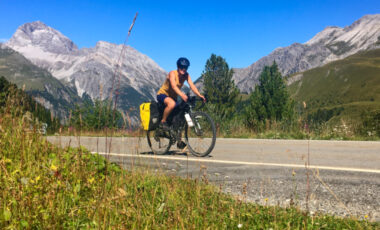In the summer of 2022, Rob and I cycled across Europe. Well, not all the way across; we cycled coast to coast from Hook of Holland to Venice. But “cycling across Europe” has a nice ring to it, and as newbie bike tourers we like the idea of cycling across a continent (almost). Plus, it was easier to describe the trip to people before and after the event. So, we rolled with it and took it with us on our first human-powered journey in Europe, bike touring.
In this article you’ll find information on the route we took, what we took with us, how we prepared and our general experience of the trip.
But without giving too much away, we absolutely LOVED almost every minute of our trip biking across Europe. And we’d highly recommend it to those new to the freedom and joy of bike touring life.
- Planning a bike touring trip in Europe
- Europe bike touring: The route
- How to prepare for a 2000 km bike trip across Europe
- Mapping and navigation
- Gear and clothing for bike touring in Europe
- Food on a European bike tour
- Camping on a European bike tour
- Stelvio Pass
- Cycling in Italy
- Flying with a bike
- Europe bike touring: top tips
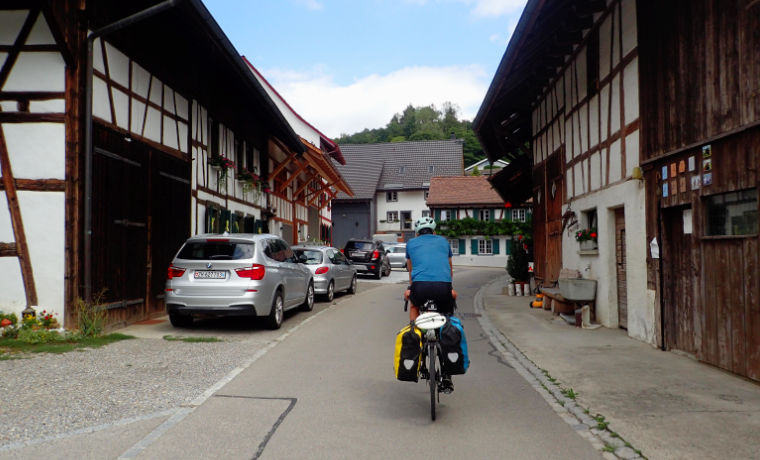
Planning a bike touring trip in Europe
The first step in our journey cycling across Europe was putting aside some dates. Once we’d ring-fenced 5 weeks during the summer, we were able to set about deciding which route to take.
This was no mean feat as there are a ton of great cycle routes that wiggle and wind their way in every direction across Europe. Could we really cycle from the UK to Istanbul in 5 weeks? After only a very small amount of research we declared that we could not! Some cyclists most certainly could and do. But we are bimblers and sightseers first, cyclists second. And we wanted to enjoy our trip. We settled on around 50 miles / 80 km per day as a guide to what we could reasonably achieve in the time we had.
Researching the potential route options led us very quickly to the EuroVelo website: THE place to go for people interested in cycling in Europe. EuroVelo is an initiative of the European Cyclists’ Federation (ECF) and is a network of 17 long distance cycle routes across the continent. And with over 90,000km of cycling itineraries available, it was time to figure out which one was for us!

Europe bike touring: The route
Distance: 2100 km / 1240 miles
With a rough distance of around 2000 km in mind we finally decided upon a one-way route. We were both pretty keen not to fly, both environmentally and bike-faff-wise. However, we also really wanted to experience lots of different countries and relished the idea of cycling over the Alps. Plus, it sounded pretty cool saying we were cycling to Venice! Cycling along the Rhine for a bit and then back across France (which was another option we were considering) didn’t quite have the same ring to it.
We booked our overnight ferry from Harwich to Hook of Holland which gave us 38 days to get to Venice before our flight back. This very casual schedule allowed for around 1 rest day each week and four days at the end visiting Venice and Treviso. And sleeping!
The schedule also allowed for low-mileage days crossing the Alps. We’d never cycled in the mountains before, let alone on a bike full of camping equipment and gear. So we had no idea how long this would take and didn’t want to rush what we anticipated being the most spectacular part of the trip.
So, what was our route, exactly?
The simple(ish) answer:
We cycled from Hook of Holland along the EuroVelo 15 (ish) which predominantly follows the Rhine to the Alps. Then over the Alps, alongside Lake Garda and across to Venice.
The long answer is FAR too convoluted for text. So instead, you can check out our route in Polarsteps.
We used Polarsteps to keep our families up to date on our progress without having to be sending messages every other day and constantly being on our phones. It’s also a really nice and concise record of our trip for us.
How to prepare for a 2000 km bike trip across Europe
As mentioned, we don’t class ourselves as “cyclists”. We love cycling and really love exploring by bike. But, unlike “proper” cyclists, we don’t live for the hills (in fact, I hate hills) and we’re certainly not into stat collecting.
With this in mind, we were aware that we may need to get some training in before we embarked upon our journey, so we simply just started cycling more and for longer than normal, when we could. However, we also felt like we’d gain cycle fitness on the trip. The first couple of weeks of the planned route followed a huge river so we were unlikely to need any hill training for that. And by the time we reached the Alps we figured we’d be fit and strong enough to take it on. It was more about getting our backsides accustomed to more than an hour or two at a time in the saddle.
A trial run
The main bit of measured prep that we did was a weekend trial run. We packed up our bikes with all the items we’d be taking across Europe and did a two-day cycle trip locally. This was invaluable and an excellent way to figure out lots of stuff before we went.
The route was pretty hilly with a headwind for all of the second day and I found cycling with a fully loaded bike way more challenging than I’d thought I would. It spurred me on to get some more training rides in. But the weekend also helped iron out some questions about our camping setup and clothing choices as well as learn some valuable navigational lessons.
TOP TIP: If you’re new to bike touring and only do one bit of “training”, I highly recommend doing a weekend trial run.
Mapping and navigation
Prior to our European cycling trip we used to just use our phones for navigating bike rides. Or we’d be with other folk with fancy GPS devices so we never really felt the need for anything other than a phone. We also thought that the EuroVelo 15 would be signposted well enough to not need to rely on GPS mapping.
However, after a little bit of reading and research, we decided to invest in a Garmin before the trip. And we are SO glad that we did. The signposting on the EuroVelo 15 is either brilliant and frequent or completely non-existent! We would have wasted hours each day on route finding. But we also would have seriously struggled to keep the batteries of our phones charged. Not to mention just how easy following a GPS device is. After a few teething problems (ironed out on our trial run) we learned to love Marvin, our trusty Garmin.
Mapping
Before we set out on our journey we had pretty much the whole route planned out. We used cycle.travel to easily create sections of the route. It automatically creates a route (that you can tweak to suit) along bike trails and you can choose how much on or off road riding you want to do. Crucially, it also calculates the elevation gain of each route. This massively helps in terms of mileage expectations and planning in hilly areas, like crossing the Alps!
Once we’d created our route sections we then downloaded the routes as GPX files and transferred the files over to Marvin (our GPS device) via the Garmin Connect App.
The process of mapping out our route prior to the ride gave us confidence that we could definitely achieve our goal AND take some rest days along the way. It also gave us an idea of what we were likely to see along the way so that we could plan some sightseeing into the trip.
However, by the end of day one we were already re-mapping and straying from our proposed route!
Re-mapping and flexibility
Being flexible when bike touring is essential. Things don’t always go to plan, for very many reasons. And you’ve got to be OK with adapting and changing plans as you go.
As such, we found ourselves making rough plans a few days at a time as we went, mapping out sections of our route using the same process as above, but on our phones. Yes, this meant that we had to spend time on our phones in the evenings, which we really didn’t want to do. But it also allowed for flexibility to change plans as we went, which we did a lot!

Gear and clothing for bike touring in Europe
Choosing gear and clothing for bike touring is most certainly not an exact process. And the more you tour, the more you’ll fine tune your setup.
That said, doing a trial run really helped us get our gear and clothing right for the big trip. As such, there’s very little we’re planning on changing for future trips other than clothing to suit the weather conditions.
For detailed information about what we took on our cycle in Europe, read our guide to bike touring gear which includes a handy checklist and details of exactly what we took.
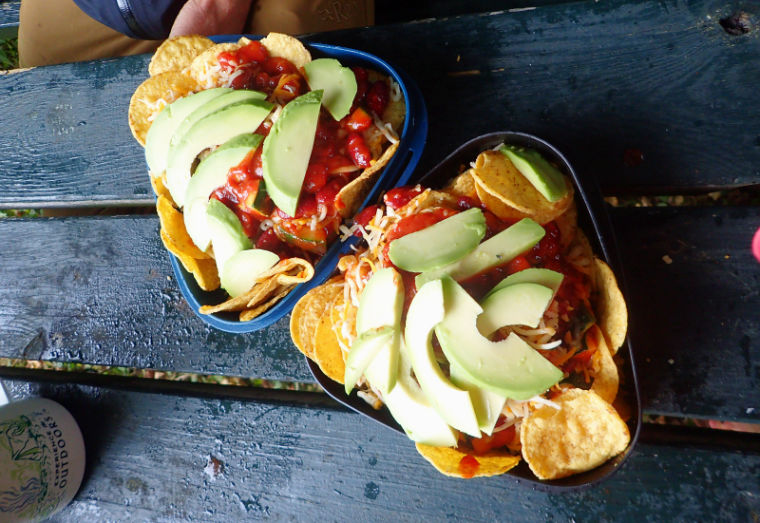
Food on a European bike tour
Everyone eats differently when they travel, depending on budget and preferences. But also depending on what’s available. Thankfully, access to great food when cycling in Europe is not an issue and eating local cuisine is one of the great joys of travelling by bike.
We started the trip with a rough budget, which I highly recommend as it’s VERY easy for frugality to go out of the window when you’re starving after a long day on the road and just want to eat a quick hot meal.
We also really enjoy camp cooking, so it was easy for us to stick to cooking almost all of our evening meals at the campsites. To make this even easier, we aimed to stop at a supermarket as close to our campsite as possible so that we didn’t have to carry our food too far.
Our afternoon supermarket shopping trips would usually include buying:
- Beer and crisps for a post-ride snack
- Main meal
- Dessert or chocolate
- Breakfast for the next few days (usually muesli)
- Snacks for the next few days
- Lunch for the next day
Breakfasts
To keep things simple, we ate pretty much the same thing each morning:
Tea / coffee
Muesli soaked overnight in water with nuts, seeds and raisins
Soaking overnight meant that we didn’t need to buy milk and also made everything easier to digest before getting on our bikes. We’d buy a bag of muesli and mixed nuts every few days.
Lunches
We tended to eat out more at lunchtimes than make our own lunches. Firstly, it was a nice way to break up the day and force us to rest. Secondly, it enabled us to sample the local cuisine without dipping too deeply into our budget. And finally, it made us stop and appreciate places instead of just rolling right through them.
All that said, we most certainly didn’t have a budget that allowed us to eat out everyday and we didn’t want to eat out everyday either; both of us love a picnic! Also, there weren’t always places to eat in more rural areas. And some places (Switzerland) were far too pricey to even consider eating out!
When we weren’t eating out, our lunches usually included:
Bread or crackers
- Tomatoes or avocado
- Tubed mayo or mustard
- Cheese or boiled egg
- Crisps or peanuts
- Fruit or cake
Strangely, the above combo never got boring!

Evening meals
Most of the supermarkets across Europe are stocked with good supplies of almost everything so we were able to eat very well every evening within our budget.
It’s worth noting that even the supermarkets in Switzerland were breathtakingly expensive leaving us gasping at the €8 price tag on a bar of Milka. Even a large bag of crisps cost €5! With a little shopping around the isles we were able to make up some satisfactory meals out of the slightly cheaper items on the shelves. But we also took some detours across the border to Germany to get our supplies.
Our evening meals included:
Ragu and Smash
- Chilli nachos
- Tofu stir-fry
- Curried coconut and mackerel noodles
- Gnocchi and veg
- Salmon and couscous
- Filled tortellini
- Macaroni with sweet chilli and veg
- Mushroom stroganoff
- Beetroot and mushroom spaghetti bolognaise
- Curried noodles with lentils, sweet potato and veg
- Halloumi and pepper stew with gnocchi
- Mango, bean and avocado couscous
- Vegan weiner and mushroom risotto
- Falafel and anti-pasti couscous
- Egg salad
Shopping everyday for food is time consuming, especially when you’re tired and hungry! It’s also not the most cost effective way of cooking and if your budget is tight then buying a few items in bulk will definitely save you some pennies. But if you’re able to, shopping each day means that you don’t have to carry food unnecessarily and you can eat fresh ingredients daily too. That said, we tended to always have a lightweight meal option in our bags, just in case.
When we knew we had a long day on the road the next day, we’d buy a pre-made pasta packet and sauce so that we’d have something quick and easy to eat at the end of the day and didn’t need to faff around with supermarket shopping on an already tight schedule. Many of the campsites also had shops so we were able to supplement our meals if needed (usually with crisps and beer!).
TOP TIP: Most supermarkets close on Sundays in Europe. This caught us out to start with. But we didn’t make the same mistake twice and made sure to stock up on Saturdays.
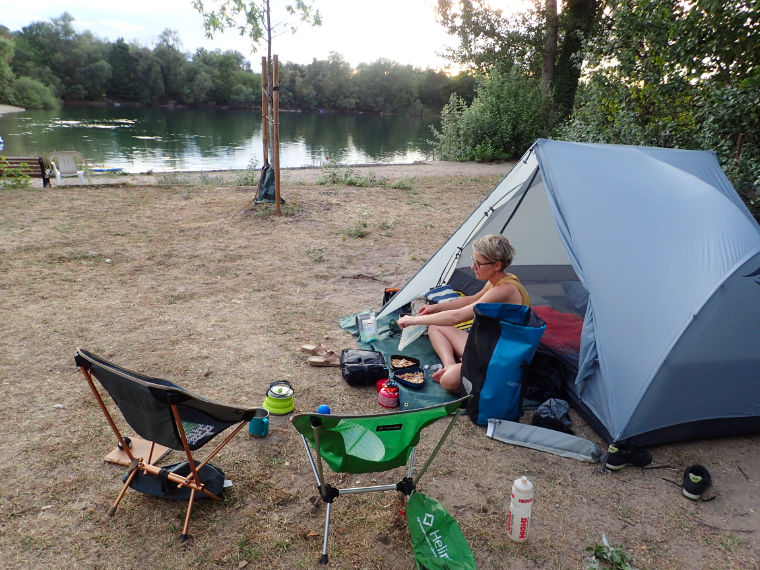
Camping on a European bike tour
Camping in Europe is huge! Not only are there a ton of campsites to choose from but there are also lots of different types. From full-blown resorts with residential camping villages to tiny patches of land with a shower and toilet, and everything in between.
Obviously, some are more pricey than others and it’s worth doing a bit of research if you’re on a tight budget. This may also dictate the route you choose.
We originally planned on just rocking up to campsites as we passed them. Or at least aiming for one and hoping they had space. However, day one in the Netherlands taught us very quickly that this method doesn’t always work. It was a weekend in the summer holidays and we were also near a town where a festival was taking place. As such, all of the nearby campsites were full and we had to cycle another hour or so to find one with space.
TOP TIP: Book weekend campsites ahead of time.
Campsites were generally pretty good at fitting in cyclists with a small tent. However, the weekends through the summer were always busy so we called ahead a few days to book weekend sites.
As the trip went on, we got into a routine of planning our route and booking camping for two or three days ahead. This enabled us to plan in rest days but also took away a degree of stress over whether we’d have a place to sleep or not.
Wild camping
We were open to wild camping if we needed to. However, the deeper into Europe we got, the more resistant to this we became. This was mainly due to the rapidly rising temperatures of the 2022 heatwave; the idea of not having a shower after cycling 80km in 35ºC heat was unappealing, to say the least! And most of the lower Rhine (which is where we could have done with some wild camping options) isn’t safe to swim in.
So we ended up not wild camping at all, which suited us very well. Not only for cleanliness but being on campsites enabled us to relax more, meet other people and feel secure.
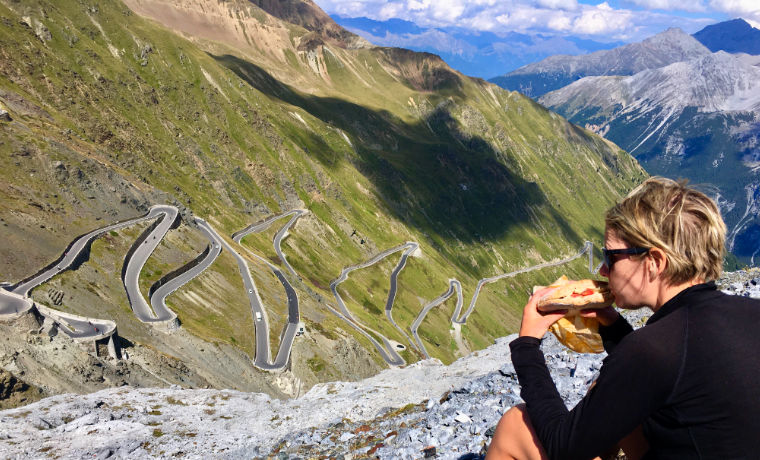
Stelvio Pass
The route we chose to take over the Alps was largely dictated by our desire to take on the Stelvio Pass. This iconic pass is the second highest pathed road in the Alps. And at 2,757 m (9,045 ft) and 48 switchbacks, it makes for one heck of a day trip by bike.
Needless to say, we didn’t attempt this with loaded bikes, although we did see some people doing so! Instead, we based ourselves for three nights at a campsite just outside Santa Maria Val Mustair on the northern side of Stelvio.
Day one of our mini-break was spent resting, eating, strolling, snoozing, bike maintenance and generally chilling out.
Conversely, day two was spent slogging our way up and over the Stelvio Pass. It was epic! And although my legs hated almost every minute of the 48 gruelling switchbacks, I may have slowly started to enjoy cycling up hills.
The views were incredible. The weather was perfect. Unexpectedly, the camaraderie was also a joy. Predictably, I was constantly being passed by lycra-clad team riders gunning it to the top in record time. But despite their single-minded focus and determination, they were all super encouraging and supportive of me slowly plodding my way to the summit, happy at the idea of just making it there.
And make it, I did! It took me almost 3.5 hours, but I did it. For reference, the record from Prato, which is where we started, to the top of the Stelvio Pass is 1:15 (men) and 1:25 (women).
Could I have done it faster, probably. Would I have enjoyed it? Definitely not! Many people struggle with the lack of oxygen once you get to a certain altitude. But in all honesty, my lungs felt fine. It was my legs, glutes and lower back that felt it more than anything else. I guess if my muscles were more accustomed to riding uphill for hours I’d probably feel it more in my lungs as I’d be able to push it more.
Once at the top we ate chips and a massive cheese and tomato-filled baguette and drank cola. Then after a post-ride/sugar slump we enjoyed the most glorious scenery of the Umbrio Pass route back to our campsite to prepare for getting back on the road to Venice the next day.
This detour, though not restful in any way, was most definitely one of the highlights of the whole trip. And for even the most hill-averse cyclists out there, I highly recommend giving it a go.
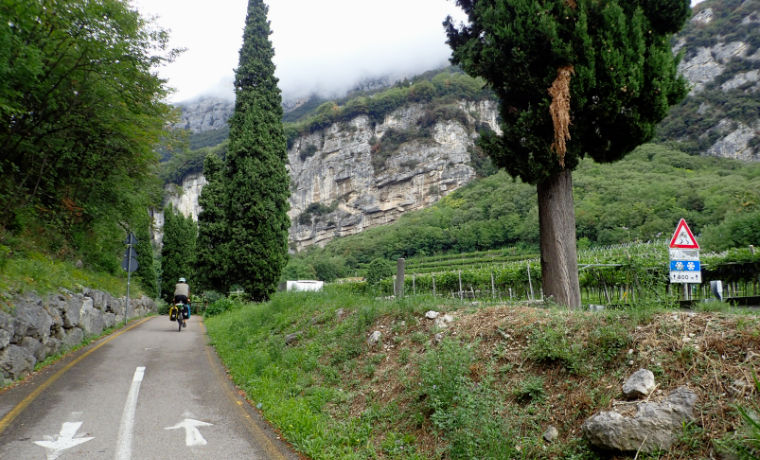
Cycling in Italy
Before we left, we didn’t know much about how cycling in Italy would be. We’ve experienced the roads as drivers and it’s safe to say that it’s not an experience for the faint-hearted and assumed that cycling would be even more treacherous. So we were absolutely delighted at the experience we had there as cyclists and as tourists.
Firstly, the cycle route network is comprehensive through northern Italy. As such, we found ourselves enjoying delightfully well-maintained and mostly tarmac cycle paths almost all the way from the Alps down to Lake Garda.
Cycling around Lake Garda wasn’t much fun as the roads are narrow, busy and go through lots of tunnels. But this was only a very short section of a day or so and the scenery more than made up for it.
Then from Peschiera Del Garda across to Mestre, via Verona and Vicenza, we followed a network of dedicated cycle paths and very quiet country lanes. Easy, safe, scenic and highly enjoyable.
Budgeting for bike touring in Europe
You’ve probably figured out that we had a moderate to decent budget for our trip. Yes, we camped every night instead of booking into guest houses and we cooked most of our meals. However, we ate out a good amount too and certainly didn’t miss out on a daily post-ride beer and enough crisps to raise our cholesterol up to worrisome levels!
Our budget was around €60-70 per day for the two of us. This felt like loads in some areas where camping was only around €20. However, in Switzerland it was around €40 for camping and food was considerably more pricey there too. It all evened out in the end.
We could have definitely spent less on our daily groceries; not bought alcohol, stuck to basic (and boring!) meals and not splashed out on naughty snacks. But we really love eating well. And this was our holiday, afterall!
Flying with a bike
Getting your bike and all your gear on a plane requires some logistics and planning. Firstly, don’t forget to add a bike to your luggage allowance when you book your flight. Depending on the airline, this should cost around €50-100. But also check their guidelines. Some airlines have very specific requirements and sizes for bike boxes or bags and can charge extra on the day if your package doesn’t meet them.
Secondly, arrange with a local bike shop to pick up a bike box at the end of your trip. Before we set out on our trip, we emailed the very helpful owner of Andrea Piovesan Bike Shop in Treviso who set aside two cardboard bike boxes for us, free of charge.
Thirdly, allow time to pack your bikes up! Because the bike boxes were too big for the airline requirements, we had to cut them down to size and also cut handles into them so we could carry them. This took a good couple of hours and isn’t something a recommend doing if you are in a rush to catch a flight! We also scavenged some bubble-wrap from the bins outside some local shops to secure everything inside the boxes.
We managed to get some of our other belongings into the boxes, though you’re not supposed to. It helped to secure the bikes and also meant we didn’t have too much luggage to check-in or carry.
Aside from cycling up Stelvio, getting the bikes and our luggage to the airport was one of the most physically demanding parts of the trip!! We had to walk between public transports carrying everything. This was completely exhausting, especially on the arms. So if possible, getting a taxi (that’s big enough to carry large bike boxes) would definitely be preferable.

Europe bike touring: more top tips
A big part of taking on a trip like this is making your own mistakes as you go, learning from them and adapting. It’s all part of the experience and although overcoming things can be a challenge at the time, you’ll gain something positive from it, if nothing more than a good story!
That said, it’s always useful to do your research and take advice before and during your trip, if you feel you want it. With this in mind, here are some tips that you may or may not find useful if you are planning your first biking tour in Europe:
- Invest in a GPS device for your navigation.
- Use a small solar panel to recharge your devices.
- Pack a packable backpack to easily carry groceries on your bike, and for sightseeing days.
- Carry washing detergent to hand-wash your cycling shorts each evening.
- Add rehydration tablets to your water but also drink plain water.
- Book campsites ahead of time during peak times and at weekends.
- Learn how to book campsites over the phone in different languages – English isn’t as widely used as you might expect.
- Try not to max out your daily budget in cheaper areas – you’ll need the buffer in more expensive places.
- Try not to miss the sights! If you find you don’t have time to explore then reduce your daily mileage. You can always make up time on a train if you have to.
- Keep on top of your progress on the route to make sure you stay roughly on schedule with the time you have.
- Clean and lube your bike every few days; you’ll enjoy the riding so much more on a well oiled machine!
- Learn some basic bike maintenance before you go.
- Talk to other cyclists and don’t be afraid to adjust your route based on their experiences / advice.
- Arrange a bike box for flying ahead of time.
Having read about our experience of Europe bike touring as newbie tourers, I hope you feel inspired to give it a go yourself. If you do decide to take on a biking tour through Europe and have any questions about any elements of our trip then don’t hesitate to get in touch – we’d love to help!


